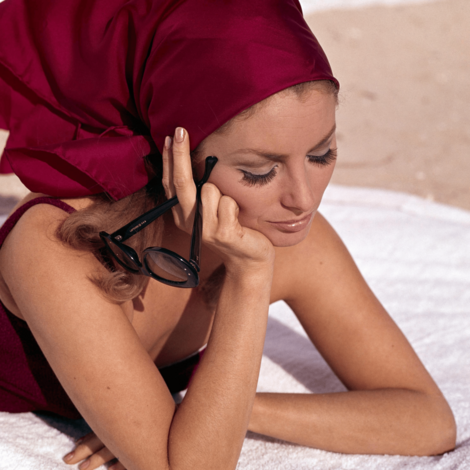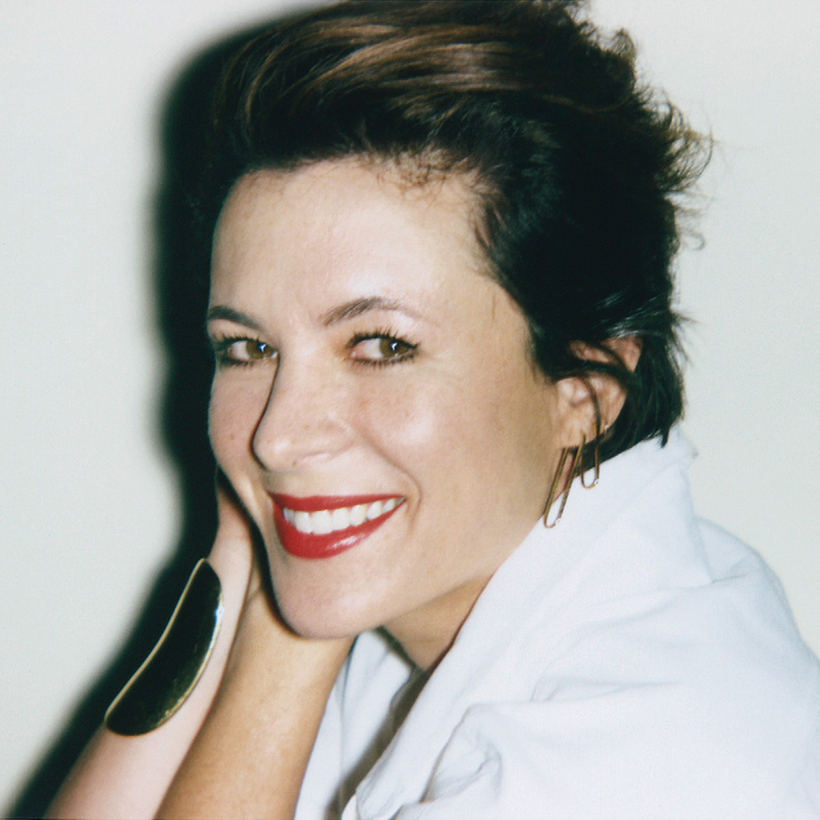Garance Doré has been many things—most recently, the founder of a new beauty line and a members-only online community. Yet the first line of her obituary might still include “original front-row influencer.” It’s the least relevant part of her C.V., and the one she’s been most eager to escape.
As the influencer phenomenon has worn on for well over a decade now, a life cycle is starting to emerge: first comes mounting attention and money, then comes anxiety and existential burnout.
Such was the case for Doré, who, since stepping away from fashion-show-going, has remade her life in a far less public way. Now, at 48, she’s found some equilibrium, but it was a bumpy road, with a wee nervous breakdown along the way. “I became what I hated,” she says, at a café on the less populous side of the Butte Montmartre.
An associate had originally suggested for our meeting a prissy boutique hotel with an eye-wateringly expensive menu. Doré needed the recommendation because she has less connection to Paris than you’d think, having lived in the city for only a few years. (The U.K. is her home base today.) The dessert menu had île flottante. We rolled our eyes and beat it around the corner for a Cobb salad and cheesecake.
Since 2006, when Doré launched her first blog, she has contributed to the shift in the once reluctant fashion industry to the digital realm, picture by picture, post by post. If you can remember as far back as 17 years ago, nobody in the luxury design houses would deign to have a Web site. It took fashion bloggers, seen as grubby and gauche, to prove the value of an online audience.
Today, she is a paragon of Parisian style, even though she grew up in Corsica, now lives in Somerset, and her name is neither Garance nor Doré. Née Mariline Fiori, she was born scrappy. From the tiny village of Girolata, Corsica, accessible only by boat or donkey, she didn’t come from the kind of people who rewarded sitting around looking pretty. The eldest of four, she was expected to earn. Her parents owned a restaurant called Le Bel Ombra, a favorite of passing yachtsmen including Gianni Agnelli. Her father grilled the fish while her glamorous mother greeted the guests. Doré worked there as a teenager to pay for trips to England and America to learn English. She borrowed her father’s kitchen to make croissants over summer holidays, which she peddled by boat. (One of her other jobs, as a windsurfing instructor on a nude beach, didn’t last quite as long.)
Today, she is a paragon of Parisian style, even though she grew up in Corsica, now lives in Somerset, and her name is neither Garance nor Doré.
After university she relocated to Marseille to become an illustrator, a career her parents didn’t approve of. But trips back and forth to Paris to hustle her portfolio netted very little. “I realized when I started actually getting work that I couldn’t make a living doing it,” she says.
Doré thought a blog might help launch her career, so she learned Photoshop and, in 2006, gave birth to Une Fille Comme Moi. Like most of her peers, she decided to go anonymous, but where they called themselves “Fifi57” or “Girl in the City,” she went for something more distinguished. “Garance Doré” combined two colors, red and gold, recalled the artist Gustave Doré, and made her sound posher and more classically French than Corsican. It created the distance she needed to express herself about fashion and life. She clearly had an eye and a voice, and it had nothing to do with Parisian-fashion froideur. She was refreshing.

Une Fille Comme Moi found its audience quickly, thanks to the self-supporting community of fashion blogs that were starting to catch the attention of print media. “I launched in June, and by the end of that summer, I started getting requests for interviews,” she recalls. “I was very shy and not media-ready, but I started feeling that something was happening, and if I was going to have a chance, this was it. So I took all the money I had [$2,000], and moved to Paris.” She was 31.
Paris was her fashion graduate school. Doré started snapping pictures of women on the street as a way to understand this higher level of style. Soon she met Scott Schuman, a photographer with his own ascendant blog, the Sartorialist, and they became a couple. Street-style photography valorized individual, often eccentric takes on fashion. What was happening outside the shows started to become as exciting as what went on inside.
“Scott was the first person in my life who said, ‘You have real talent,’” Doré says. With his American, can-do gumption, “he really pushed me.” Doré re-settled, moving into Schuman’s Greenwich Village apartment. The two became the buzziest megaphones, the Brangelina of bloggers, collaborating on high-profile branded projects including Tiffany & Co.’s True Love in Pictures series. By 2012, the Council of Fashion Designers of America would anoint the couple with a prestigious Eugenia Sheppard award for journalism. It was like she blinked and they became the Establishment.
Doré started to overtake Schuman. It helped that, as people said, she was simply easier to work with, as endearing as her writing. Schuman, who had left his wife of 20 years to pursue the relationship with Doré, and who made loutish comments about Doré while they were together, was known to be prickly. She was also branching out, founding Atelier Doré, a creative agency that churned out blog content and campaigns for Net-a-Porter, L’Oréal, Louis Vuitton, Estée Lauder, Nars, Tiffany, and Shiseido.
Doré was not a typical branding executive. “Garance was always most comfortable working from her couch,” says Emily Yeston, who started as an editorial assistant for the still-tiny Atelier Doré in 2011 and is now her business partner. “We would laugh because there was a desk in the office that was for her, but we would sit at it and eat lunch.”
Doré was never a clotheshorse, either, though she cut a stylish figure with her high heels and big camera. It made sense, as the influencer economy was gaining traction in the 2010s, that brands would want her visibly in their front rows. Designers invited her and sent clothes, and she went along, happily accepting their largesse. Like many at the time, she was making it up as she went along. Why not?
And then, in 2014, after seven high-profile years, Schuman and Doré broke up. Both issued carefully worded statements on their respective platforms. The news was gossiped about in the Cut, Gawker, and even the Daily Mail, in which Schuman was (rather snobbishly) quoted as saying that the two were “brought up differently.” (He was also quoted in The Globe and Mail, saying, “I’m pretty good at the sex. And pretty good at picture taking. That’s about it.”)
Meanwhile, the digital media world was evolving. Instagram essentially flipped the camera around. “If you’re a photographer, you take photos at shows,” she says. “But if you’re an influencer, you’re there to be looked at.” Doré always shared her personal life in her writing, and on her podcast Pardon My French, but “when Instagram arrived, the camera turned on me. I’m a narcissist, like everyone else, but it didn’t feel so interesting. I couldn’t stay high on myself for very long.”
Like many people who are unhappy and not sure why, Doré thought the problem was her. “I tried to play the game for a while. I even hired a stylist.” When she found herself whining about seat placement, she horrified herself.
Her book, Love Style Life, filled with her writing and illustrations, came out in 2015. By 2016, she relocated to Los Angeles and fixed up a house in Mar Vista, where she hoped to slow down and start a family with her musician boyfriend. That didn’t work out.
“The depression settled in slowly,” Doré says. “I was making money because I still had some contracts with brands, but I wasn’t writing. It was an L.A. depression where your psychic tells you you’re wonderful and you’re probably channeling, and you talk to angels.” The relationship went bust; she was structureless and developed dangerous levels of magical thinking. “I turned around and saw that I hadn’t done anything.” She had no energy to wrangle interview subjects for her podcast, and so she shut that down, too. A proper psychiatrist, with proper meds, came to the rescue.

“With everything I lived, all the glamour, the money, the recognition, the clothes, the trips, when everything calmed down, there was only one thing I missed,” Doré says. “It wasn’t money; it wasn’t success. It was writing for someone who understands me.” Doré stopped covering style on her Web site, and she and Yeston formally closed Atelier Doré, getting out of their expensive Bowery lease on the eve of the pandemic. Then, right as the world went into lockdown, Doré launched a newsletter. She was back to her first love: cranking out content from her couch.
And it worked. What began as Garance.world grew fast enough that she decided to put it behind a paywall to keep the community manageable. It’s just moved to Substack, changed its name to “The Highlight,” and charges $7 a month or $70 a year. In it she explores careers, love, health, fashion and style, and childlessness—all things Doré has written plenty about before, with charm and candor. “Not that I’m the first, but anything that creates opportunities for people to come together” feels right to her now.
Meanwhile, Yeston was casting about, looking for a job. “A founder said, ‘Oh, you should totally start a beauty brand,’” she says. “I was like, ‘Absolutely not. It’s such a crowded space. That’s insane.’” Then, while shopping for some micellar water, the gentle, watery cleanser that was made popular by Bioderma and Avène, to calm her irritated skin, she had trouble finding a formula without parabens or fragrance of any kind. Aha.
Yeston saw an opening for a new interpretation of French pharmacy products. Who better to partner with than Doré?”
“I said, ‘No, no, the world doesn’t need another product!,’” Doré recalls. “I like ease and simplicity, and don’t believe in 90 percent of what the beauty industry is selling. Emily said, ‘Exactly.... This is why you should do it.’”
The line, conceived of as the jeans and white T-shirt of skin care, launched last May with four products, all made in a Paris lab: micellar water; a gentle cleanser that turns milky with friction; a soothing balm, sort of like Boiron’s cult Homéoplasmine; and a simple, comfortable facial moisturizer. In September, the brand added an ice roller to its product line.
The range comes in spare, minty-green packaging, and its ingredients were verified by the Environmental Working Group. It’s far from the luxury world that made Doré’s name, with nothing more than $45. Credo beauty is the primary retailer in the U.S. In France it’s at Merci. Doré won’t release sales numbers but says about half of her customers have come back for more.
“Doré products are not very glamorous,” she says. “You’re not dying to put them on your top shelf, but that’s on purpose.”
Influencers, at least professional ones, are still figuring out how to keep their audiences engaged and the good times rolling. Doré has found success in photography, illustration, podcasting, advertising—maybe beauty will be next. Ultimately, what Doré is really selling is herself. Now, she knows how to do that without selling her soul.
Alexandra Marshall is a Writer at Large at AIR MAIL and a contributor to W, The Wall Street Journal, Vogue, and Travel + Leisure. She chronicles her recent relocation to Le Perche in the newsletter An American Who Fled Paris





